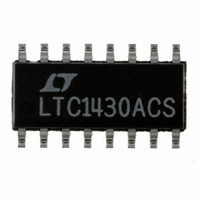LTC1430ACS Linear Technology, LTC1430ACS Datasheet - Page 17

LTC1430ACS
Manufacturer Part Number
LTC1430ACS
Description
IC SW REG CNTRLR STEP-DWN 16SOIC
Manufacturer
Linear Technology
Type
Step-Down (Buck)r
Datasheet
1.LTC1430ACS8.pdf
(24 pages)
Specifications of LTC1430ACS
Internal Switch(s)
No
Synchronous Rectifier
Yes
Number Of Outputs
1
Voltage - Output
3.3V, Adj
Current - Output
50A
Frequency - Switching
50kHz ~ 500kHz
Voltage - Input
4 ~ 8 V
Operating Temperature
0°C ~ 70°C
Mounting Type
Surface Mount
Package / Case
16-SOIC (3.9mm Width)
Lead Free Status / RoHS Status
Contains lead / RoHS non-compliant
Power - Output
-
Available stocks
Company
Part Number
Manufacturer
Quantity
Price
Company:
Part Number:
LTC1430ACS8
Manufacturer:
LT
Quantity:
10 000
Part Number:
LTC1430ACS8
Manufacturer:
LINEAR/凌特
Quantity:
20 000
Company:
Part Number:
LTC1430ACS8#TRPBF
Manufacturer:
LINEAR
Quantity:
12 711
A
be floated and an external resistor string should be con-
nected to FB (Figure 15). As before, connect the top
resistor (R1) to the output as close to the load as practical
and connect the bottom resistor (R2) to the common
GND/PGND point. In both cases, connecting the top of the
resistor divider (either SENSE
significantly improve load regulation by compensating for
any drops in PC traces or hookup wires between the
LTC1430A and the load.
Power Component Hook-Up/Heat Sinking
As current levels rise much above 1A, the power compo-
nents supporting the LTC1430A start to become physi-
cally large (relative to the LTC1430A, at least) and can
require special mounting considerations. Input and output
capacitors need to carry high peak currents and must have
low ESR; this mandates that the leads be clipped as short
as possible and PC traces be kept wide and short. The
PPLICATI
Figure 15. Using External Resistors to Set Output Voltages
4700pF
O
C1
220pF
4.7 F
C
LTC1430A
U
35V
C
S
SENSE
SENSE
+
R
7.5k
C
1430 F15
I FOR ATIO
FB
U
+
–
GND
+
NC
NC
C
0.01 F
or R1) close to the load can
0.1 F
SS
NC
NC
GND
Figure 14. Typical Schematic Showing Layout Considerations
V
W
I
FREQSET
SHDN
COMP
SS
MAX
OUT
GND
V
CC
LTC1430A
R1
R2
100
SENSE
SENSE
PV
PV
PGND
CC2
CC1
I
G1
G2
FB
FB
+
–
U
PGND
NC
1 F
0.1 F
power inductor will generally be the most massive single
component on the board; it can require a mechanical hold-
down in addition to the solder on its leads, especially if it
is a surface mount type.
The power MOSFETs used require some care to ensure
proper operation and reliability. Depending on the current
levels and required efficiency, the MOSFETs chosen may
be as large as TO-220s or as small as SO-8s. High
efficiency circuits may be able to avoid heat sinking the
power devices, especially with TO-220 type MOSFETs. As
an example, a 90% efficient converter working at a steady
3.3V/10A output will dissipate only (33W/90%)10% =
3.7W. The power MOSFETs generally account for the
majority of the power lost in the converter; even assuming
that they consume 100% of the power used by the
converter, that’s only 3.7W spread over two or three
devices. A typical SO-8 MOSFET with a R
provide 90% efficiency in this design can commonly
dissipate 2W when soldered to an appropriately sized
piece of copper trace on a PC board. Slightly less efficient
or higher output current designs can often get by with
standing a TO-220 MOSFET straight up in an area with
some airflow; such an arrangement can dissipate as much
as 3W without a heat sink. Designs which must work in
high ambient temperatures or which will be routinely
overloaded will generally fare best with a heat sink.
MBR0530T1
Q1A*
* MOTOROLA MTD20N03HL
5V
Q2*
PGND
Q1B*
+
2.7 H/15A
TOTAL
880 F
(220 F
10V 4)
+
1430 F14
LTC1430A
TOTAL
1980 F
(330 F
6.3V 6)
3.3V
ON
suitable to
17














